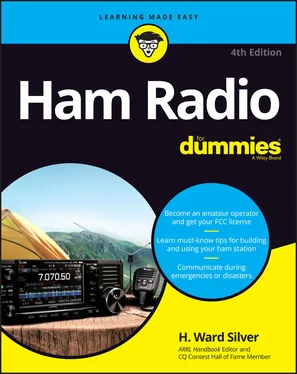Some readers have asked for more license exam study information. That would make this a very thick book! There are plenty of great study guides out there, both online and in print, for all three license classes so I don’t overlap with them. Material is available with lots of background information or in question-and-answer formats. There are flash cards, too! Just do an online search for “ham radio exam study guide” and you’ll find lots of choices.
If you’ve already received your license, congratulations! This book helps you change from a listener to a doer. Any new hobby, particularly a technical one, can be intimidating to newcomers. By keeping Ham Radio For Dummies handy in your station, you’ll be able to quickly understand what you receive on the airwaves. I cover the basics of getting equipment connected properly and the fundamentals of on-the-air behavior. Use this book as your bookshelf ham radio mentor, and soon, you’ll be making contacts with confidence.
You can read this book in any order. Feel free to browse and flip through the pages to any section that catches your interest. The sidebars and icons are there to support the main story of each chapter, but you can skip them and come back to them later.
The book has five parts. Parts 1and 2are for readers who are getting interested in ham radio and preparing to get a license. Parts 3and 4explain how to set up a station, get on the air, and make contact with other hams. Part 5is the Part of Tens (familiar to all For Dummies readers), which presents some tips and suggestions for you to get the most out of ham radio. In the online website for this book there is an extensive glossary and a handy supplement to help you with some of the basic math ham radio uses.
Within this book, you may note that some web addresses break across two lines of text. If you’re reading this book in print and want to visit one of these web pages, simply enter the address exactly as it’s noted in the text, pretending that the line break doesn’t exist. If you’re reading this book as an e-book, you’ve got it easy; just click the web address to be taken directly to the web page.
In writing this book, I made some assumptions about you. You don’t have to know a single thing about ham radio or its technology to enjoy Ham Radio For Dummies, 4th Edition, and you definitely don’t need to be an electronics expert to enjoy this book.
But I ask two things of you:
You have an interest in ham radio.
You can get online.
Due to the broad nature of ham radio, I couldn’t include everything in this book. (Also, if I’d done that, you wouldn’t be able to lift it.) But I steer you in the direction of additional resources, that will help you get more out of this book with current information and more explanations.
While you’re reading, you’ll notice icons that point out special information. Here are the icons I use and what they mean.
 This icon points out easier, shorter, or more direct ways of doing something. Tips also let you know about topics that are covered on the license exam.
This icon points out easier, shorter, or more direct ways of doing something. Tips also let you know about topics that are covered on the license exam.
 This icon goes with information that helps you operate effectively and avoid technical bumps in the road.
This icon goes with information that helps you operate effectively and avoid technical bumps in the road.
 This icon signals when I show my techie side. If you don’t want to know the technical details, skip paragraphs marked with this icon.
This icon signals when I show my techie side. If you don’t want to know the technical details, skip paragraphs marked with this icon.
 This icon lets you know that some regulatory, safety, or performance issues are associated with the topic of discussion. Watch for this icon to avoid common gotchas.
This icon lets you know that some regulatory, safety, or performance issues are associated with the topic of discussion. Watch for this icon to avoid common gotchas.
In addition to what you’re reading right now, this book also offers free access-anywhere information at www.dummies.com . This includes two appendixes: a comprehensive glossary and some tutorials on “radio math” that are part of ham radio. There is a long list of short entries and tips on topics like tuning, troubleshooting, ways to operate, suggestions for building gear, and many more. You can access these at www.dummies.com/go/hamradiofd4e .
The website also includes a handy Cheat Sheet that includes a summary of your Technician (and soon-to-be General) class license privileges, common Q-signals and repeater channel info, a list of Go Kit gear, and some handy online resources for you. Just search for Ham Radio For Dummies Cheat Sheet in the Search box.
If you’re not yet a ham, I highly recommend you find your most comfortable chair and read Parts 1and 2to discover the basics about ham radio and solidify your interest. If you’re a licensed ham, browse through Parts 3and 4to find the topics that interest you most. For a bit of fun and interest, turn the pages of Part 5for tips and bits of know-how that will help you along your way.
For all my readers, welcome to Ham Radio For Dummies, 4th Edition. I hope to meet you on the air someday!
Part 1
Getting Started with Ham Radio
IN THIS PART …
Get acquainted with ham radio — what it is and how hams contact one another.
Find out about the basic technologies forming the foundation of ham radio.
Discover how hams communicate across town and around the Earth by using the natural world.
Be introduced to the various types of ham communities: on the air, online, and in person.
Chapter 1
Getting Acquainted with Ham Radio
IN THIS CHAPTER
 Meeting hams around the world
Meeting hams around the world
 Becoming part of ham radio
Becoming part of ham radio
 Making contact via ham radio
Making contact via ham radio
 Contributing to science with ham radio
Contributing to science with ham radio
Ham radio invokes a wide range of visions. Ham radio operators (or hams) are a varied lot — from go-getter emergency communicators and radiosport competitors to casual chatters to workshop tinkerers. Everyone has a place, and you do too.
Hams employ all sorts of radios and antennas using a wide variety of signals to communicate with other hams across town and around the world. They use ham radio for personal enjoyment, for keeping in touch with friends and family, for public service, and for experimenting with radios and radio equipment. They communicate by using microphones, computers, cameras, lasers, Morse keys, and even their own satellites.
Hams meet on the air, online, and in person, in groups devoted to every conceivable purpose. Hams run special flea markets and host conventions large and small. Some hams are as young as 6 years old; others are centenarians. Some have a technical background, but most do not; it’s not necessary to enjoy ham radio. One thing that all these diverse people share, however, is an interest in radio that can express itself in many ways.
Читать дальше

 This icon points out easier, shorter, or more direct ways of doing something. Tips also let you know about topics that are covered on the license exam.
This icon points out easier, shorter, or more direct ways of doing something. Tips also let you know about topics that are covered on the license exam. This icon goes with information that helps you operate effectively and avoid technical bumps in the road.
This icon goes with information that helps you operate effectively and avoid technical bumps in the road. This icon signals when I show my techie side. If you don’t want to know the technical details, skip paragraphs marked with this icon.
This icon signals when I show my techie side. If you don’t want to know the technical details, skip paragraphs marked with this icon. This icon lets you know that some regulatory, safety, or performance issues are associated with the topic of discussion. Watch for this icon to avoid common gotchas.
This icon lets you know that some regulatory, safety, or performance issues are associated with the topic of discussion. Watch for this icon to avoid common gotchas. Meeting hams around the world
Meeting hams around the world










